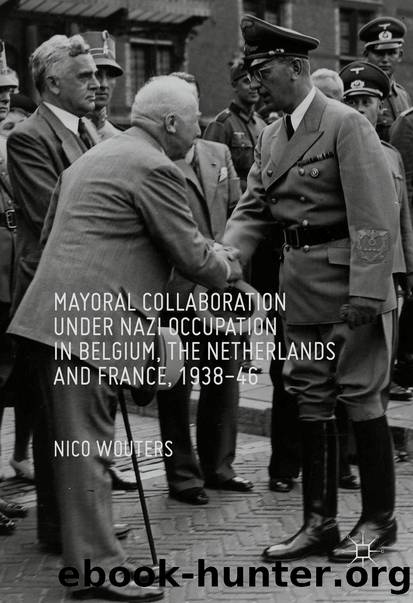Mayoral Collaboration under Nazi Occupation in Belgium, the Netherlands and France, 1938-46 by Nico Wouters

Author:Nico Wouters
Language: eng
Format: epub
Publisher: Springer International Publishing, Cham
The Issue of Illegal Arrests: Jewish Persecution
The persecution of the Jews is an obvious key topic to assess the place of local governments and mayors within a larger repressive system.
On the eve of WW II, about 65,000â75,000 Jews lived in Belgium. 170 The large majority of these were immigrants who did not hold Belgian citizenship. By the end of 1940, only 6.6 % of the registered Jewish population held Belgian citizenship. This was in sharp contrast with France and the Netherlands. According to Patrick Weil, of an estimated total of 330,000 Jews in France, 58 % held French citizenship. 171 In the Netherlands, 80 % of the Jewish populations were Dutch citizens.
The Belgian secretaries-general refused to implement anti-Jewish decrees themselves, mainly on the grounds that it would be unconstitutional. 172 The German military government in Brussels accepted this without much resistance, and issued its own German decrees, starting with two simultaneous decrees of 28 October 1940. 173 Ultimately, the German authorities would issue a total of 18 anti-Jewish decrees in Belgium, which followed the standard pattern of exclusion, registration, isolation and physical marking as the final stages before deportation. On 25 November 1941, the Association of Jews in Belgium (AJB) was created, with mandatory membership. One of the last German decrees was the imposition of the yellow Jewish Star (27 May 1942).
In October 1940, the Brussels military government nevertheless pressed for Belgian cooperation in local implementation. Instead of simply referring to the argument of non-constitutionality (which the Germans had already accepted), the secretaries-general sought backup from Belgiumâs top legal experts. What is remarkable is that neither the leading Belgian jurists nor the secretaries-general referred to the Hague Convention (which forbade such forms of persecution). They could have done so; unlike the Dutch Zivilverwaltung, anti-Jewish policy was not a priority for the Brussels military government in 1940. Without a doubt, this was a conscious omission. Jews were sacrificed by the Belgian authorities in the name of the general modus vivendi. The large majority of Jews in Belgium were non-Belgian citizens. Only when anti-Jewish policy became more severe were there Belgian protests (early 1942). 174 However, this mostly concerned the small minority of Jews with Belgian nationality.
As far as the French zone rattachée was concerned, only 4000 Jews lived in both departments before 1940, half of whom were in the urban region around Lille (La Madeleine and Marcq-en-Baroeul). 175 This small number was further reduced after the exodus of MayâJune 1940, although in 1942, both departments together still counted 690 registered Jewish companies.
The legal framework in Nord/Pas-de-Calais was a sort of hybrid Belgian-French construction. The initiative was launched by the French government. The Jewish statute was installed by a Vichy-law of 3 October 1940. 176 Official anti-Jewish policy in the north would start with the German decree of 18 November 1940. It was basically a synthesis of the two first German anti-Jewish decrees issued in Belgium several weeks before (28 October). 177 One month later, a French law would establish the French equivalent of the Jewish register.
Download
This site does not store any files on its server. We only index and link to content provided by other sites. Please contact the content providers to delete copyright contents if any and email us, we'll remove relevant links or contents immediately.
| Africa | Americas |
| Arctic & Antarctica | Asia |
| Australia & Oceania | Europe |
| Middle East | Russia |
| United States | World |
| Ancient Civilizations | Military |
| Historical Study & Educational Resources |
Magic and Divination in Early Islam by Emilie Savage-Smith;(1500)
Ambition and Desire: The Dangerous Life of Josephine Bonaparte by Kate Williams(1344)
Bohemians, Bootleggers, Flappers, and Swells: The Best of Early Vanity Fair by Bohemians Bootleggers Flappers & Swells- The Best of Early Vanity Fair (epub)(1343)
Papillon by Henry Charrière(1310)
Twelve Caesars by Mary Beard(1256)
Operation Vengeance: The Astonishing Aerial Ambush That Changed World War II by Dan Hampton(1136)
What Really Happened: The Death of Hitler by Robert J. Hutchinson(1128)
London in the Twentieth Century by Jerry White(1112)
Time of the Magicians by Wolfram Eilenberger(1089)
The Japanese by Christopher Harding(1086)
Twilight of the Gods by Ian W. Toll(1084)
Lenin: A Biography by Robert Service(1045)
The Devil You Know by Charles M. Blow(985)
A Social History of the Media by Peter Burke & Peter Burke(936)
Freemasons for Dummies by Hodapp Christopher;(922)
Napolean Hill Collection by Napoleon Hill(902)
Henry III by David Carpenter;(891)
The Churchill Complex by Ian Buruma(881)
The Rise and Triumph of the Modern Self by Unknown(879)
